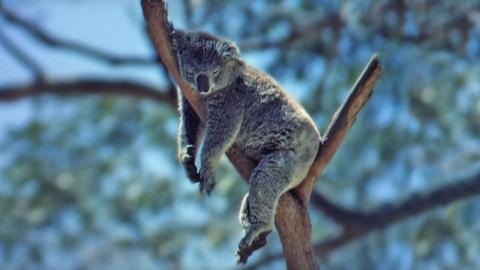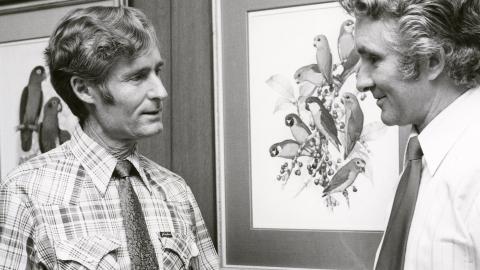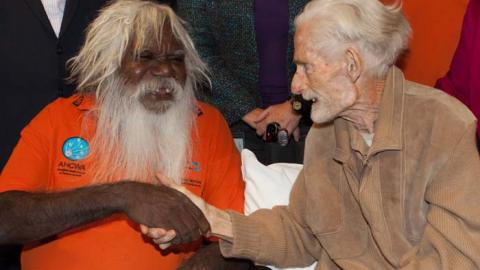

Calls of the wild
Earlier this year I was fortunate enough to work at the British Library Sound Archives as part of a staff exchange with the NFSA, researching the curatorial and archival methods used to support their highly successful ‘Natural Sounds’ section. I worked closely with the section curator Cheryl Tipp and returned to Australia with a heavy amount of information and a plethora of ideas regarding the development of our own sound collection within these specialised genres.

One of the Australian communities I discovered whilst on the exchange is the Australian Wildlife Sound Recording Group (AWSRG). The group started in 1988, when a group of passionate individuals such as Bob Tomkins, Fred van Gessel and Bill Rankin got together for a few beers and to discuss their mutual passion for birds and the recording of their calls.
Fourteen years later the group had grown to the point that an official committee was formed and today, they have become an internationally respected private source for Australia’s vast collection of birdcalls.
Despite the high levels of expertise to be found amongst its members (including audio engineers, biologists, senior lecturers and professional sound recordists) the group is accessible to anyone with similar passions. Group members also include visual artists, musicians and those that simply love listening to the sounds of birds as they sip their morning coffee. All are welcome and have the opportunity to engage with the group’s expertise via the presentations and communal activities at their annual meeting.
Last week I was delighted to head up to Julatten, in Far North Queensland, for their annual meeting at the Kingfisher Park Birdwatchers Lodge. I arrived after lunch on the first day of the meet having experienced two flights, a bus trip and two taxi rides for a total nine hours of travel, just in time for the opening address from Fred van Gessel. I must say that I have never before had the pleasure of attending a conference in such a setting. The plenary was to be found surrounded by native trees and local wildlife, with a visual backdrop of tangled vines, giant leaves and scurrying bush turkeys. As I listened to Dr Dave Rentz present his recent discoveries amongst the Katydids species entailing his findings of ones that are as-yet undescribed, my ears were drawn to the call of a distant barn owl, the squabbling of rainbow lorikeets nearby and the chirps and splashes from a birdbath with its constant stream of bathing customers.

Other (human) presentations included that of Dr Jeremy Robertson (Senior Lecturer at the School of Biological Sciences, Flinders University), who discussed his research into the identification of bird and frog vocalisation. His work has brought to light a theory that suggests the somewhat phenomenal skills that Australian frogs utilise when listening to the calls of their (potential) mate.
Tony Baylis’s ‘Introduction to editing’ enlightened me to the studio methods of those who work specifically with birdcall. Prior to this practical presentation I was quite oblivious to their unique methods; while bird recordists may certainly undertake more standard methods in ‘cleaning up’ their sounds – such as parametric equalisation and compression – there are those who work primarily with software that utilises sound visualisation via spectrograms in order to remove unwanted background noise.
I have to confess I was dubious of the outcome. It’s not unusual for me to come across recordings of birdcalls that have been ‘cleaned up’ by implementing a lowcut at about 80Hz – sometimes even higher. Whilst this will most definitely remove the typical low rumble of traffic and air conditioners, it can also take away the warmth and body of a birdcall as experienced through its subtle low frequencies – often present in the natural reverb of the sound. The methods illustrated by Tony Baylis managed to both remove unwanted noise and retain the frequency range of the original birdcall. I can say that I will be exploring these sonic processing capabilities in future for both their typical and not-so-typical uses!
Highlights of the conference included an early morning group trip to Mount Lewis, where we were privy to a close viewing of a Chowchilla pair. Their calls to each other were unlike any I had heard before – I only wished I hadn’t left my recording device back at camp.
The other key experience would be Peter Shanahan’s presentation on his life’s work, breeding and caring for the native birds of Papua New Guinea. As the grandchild of a founder of Papua New Guinea’s coffee industry, Peter had spent many years living and working on the family’s coffee plantation in Wau. His experiences with the native birdlife began after graduation when on return to the plantation as a (and I quote from Peter himself) ‘spoilt brat boarding-house boy’, he was instructed to bulldoze bushland for the planting of a coffee field. By the end of the day, he had gathered up a number of nests and small chicks that he’d unwittingly un-homed along the way and had come to the realisation that this would not be a one-off occurrence.
The oncoming years were spent re-homing, breeding and caring for the many species of birds that were affected by the coffee plantation’s developments. Hearing him speak of his unwelcome encounters with wildlife smugglers and trials and tribulations in saving the locally homed birdlife brought a tear to my eye. It was not all a happy story but the visual imagery I have of him driving into the nearest township nursing a baby quoll in one pocket, a sugar glider in the other and a number of rainbow lorikeets sitting on his passenger seat, is enough to bring a smile to my face on the drabbest of days.
On return to Canberra I must say that it sounds very quiet. A small downpour of rain does not stir up a chorus of decidedly grumpy-sounding calling voices from beast and bug alike. There are no long-nosed bandicoots to avoid tripping over after dinner, nor white geckos to gently shoosh out my door before bed. The leaves and seedpods have shrunk back down to ‘normal’ size and I no longer have the luxury of walking bird identifiers to enlighten me about each and every bird I hear. The NFSA and the AWSRG will continue to discuss the preservation and sharing of their wealth of recordings. As a community and as individuals, the AWSRG’s work is an invaluable record of quite literally the sounds of Australia, and I look forward to the possibilities that our relationships will bring.
The National Film and Sound Archive of Australia acknowledges Australia’s Aboriginal and Torres Strait Islander peoples as the Traditional Custodians of the land on which we work and live and gives respect to their Elders both past and present.


